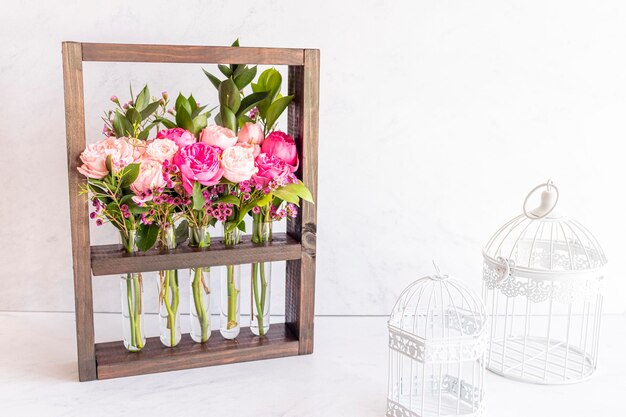Is It Safe to Store Flowers in the Refrigerator? A Complete Guide
Whether you're planning a wedding, hosting a dinner party, or simply wishing to prolong the life of a beautiful bouquet, you've probably wondered if you can put flowers in the refrigerator. It seems like a straightforward solution, yet does it really help? This question dives into the heart of preserving floral freshness, an art as delicate as the petals themselves. In this guide, we'll explore the intricacies of floral care with an eye toward practicality, so you can enjoy those blooms for as long as possible.
🌸 Why Consider Refrigeration for Flowers?
There's no doubt that flowers enhance any environment with their beauty and fragrance. However, maintaining their freshness can be challenging. Refrigerating flowers can indeed help extend their lifespan by slowing down the metabolic processes. Cooler temperatures mimic the natural coolness most flowers would experience in their habitat, delaying wilting and drooping. Let's delve into how and why refrigeration can be beneficial.
The Science Behind Flower Preservation
Flowers wilt because of a combination of factors: the plant's natural aging process, environmental stress, and ethylene gas (a natural hormone released by most plants and ripening fruits). Refrigeration tackles these by reducing the flowers' respiration rate and ethylene production, keeping them closer to their natural state for a longer period.
Optimal Temperature for Storing Flowers
Not all refrigeration is the same. The typical household refrigerator ranges between 35-40°F (1.5-4.5°C), which is generally safe for short-term flower storage. Florists, however, use specialized coolers that maintain specific humidity levels and temperatures optimally between 33-35°F (0.5-1.5°C). While home refrigerators lack precise humidity control, careful storage can potentially replicate the benefits with some strategic adjustments.
🥶 Step-by-Step Guide to Refrigerating Flowers
Safe refrigeration of flowers isn't just about sticking them next to your milk jug. It involves thoughtful preparation and handling. Here's a handy guide to doing it effectively:
Select the Right Flowers: Not all blooms take well to refrigeration. Hardy flowers like roses, carnations, and lilies fare better, while tropical flowers like orchids and anthuriums prefer warmer conditions.
Prepare the Flowers:
- Remove any leaves below the waterline to prevent bacterial growth.
- Trim the stems at an angle under running water to facilitate water absorption.
- Use floral food as directed; it helps maintain pH levels and provides essential nutrients.
Use a Clean Container: Ensure your vase or container is impeccably clean to prevent contamination.
Position Wisely: Place flowers in a secure position — ideally in the center of the refrigerator, away from the coldest spots. Ensure they are not touching produce, especially fruits that emit ethylene gas, like apples and bananas.
Monitor Temperature: If possible, maintain at the lower end of the refrigerator's range without freezing the flowers. Sudden temperature shifts can cause shock and damage.
Limited Timeframe: Use refrigeration for short-term storage. Prolonged exposure may lead to unwanted moisture absorption or cold damage.
🌿 Alternatives to Refrigeration
Although refrigeration is effective, it’s not always feasible or necessary. There are other methods to consider, especially if fridge space is at a premium:
Controlled Environment
Maintaining a cool, shaded room away from heat sources and direct sunlight is crucial. A consistent environment can have nearly the same effects as refrigeration without the potential downsides.
Regular Water Changes
Fresh, clean water is fundamental. Change the water every other day and re-cut stems for best results. This practice reduces bacteria and extends the life of the arrangement.
Use of Floral Sprays
Commercial floral sprays can prove beneficial by sealing in moisture in petals and protecting against pests and diseases, ensuring longevity.
Humidity Management
Flower longevity can benefit from humidity control. If possible, use a humidifier in very dry environments to maintain the delicate balance flowers need.
💡 Key Takeaways on Flower Refrigeration
Here's a summary of the essential points to consider when deciding if refrigeration is the right approach for your flowers:
- Temperature Matters: Ensure it's cool but not freezing — optimal floral coolers differ from home refrigerators.
- Flower Type Sensitivity: Know which flowers react favorably to cold storage and which do not.
- Prioritize Cleanliness: A clean environment prevents bacterial growth.
- Monitor Ethylene Exposure: Keep flowers away from most fruits and vegetables.
- Refrigeration Duration: Use short-term refrigeration and avoid long-term storage without proper floral facilities.
🎯 Quick Tips Checklist
- 🌡️ Optimal Temperature: 35-40°F (1.5-4.5°C)
- 🌺 Best Flowers for Refrigeration: Roses, carnations, lilies
- 🚫 Avoid Cold Damage: Do not freeze or expose to sudden temperature changes
- 🍏 Ethylene Gas Alert: Keep away from ripening fruits
- ⏰ Timeframe: Ideal for temporary storage; aim for under 48 hours when possible
🌼 Putting It All Together
Choosing whether to refrigerate your flowers is a decision influenced by the type of blooms, intended storage duration, and the available methods for flower preservation. While a refrigerator is a practical tool, understanding and addressing the unique needs of your floral arrangements will grant you the full enjoyment of their natural beauty and longevity.
The journey to preserving floral beauty is as intricate as the blooms themselves. By considering all factors — from temperature and humidity control to botanical knowledge — you can harness the power of refrigeration and other methods to extend the lifespan of your cherished floral displays. After all, each flower tells a story, and we're here to help you keep that story alive for as long as possible.
